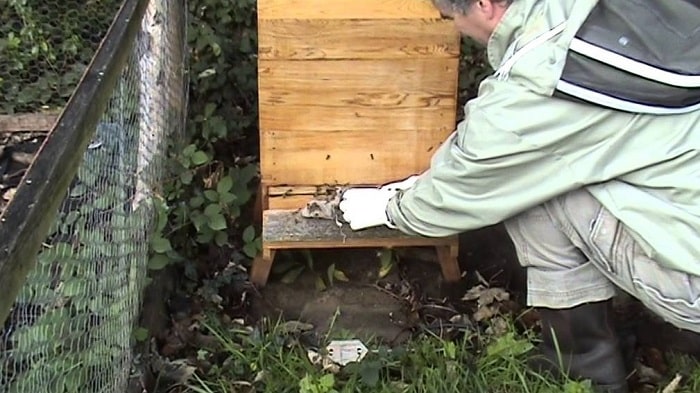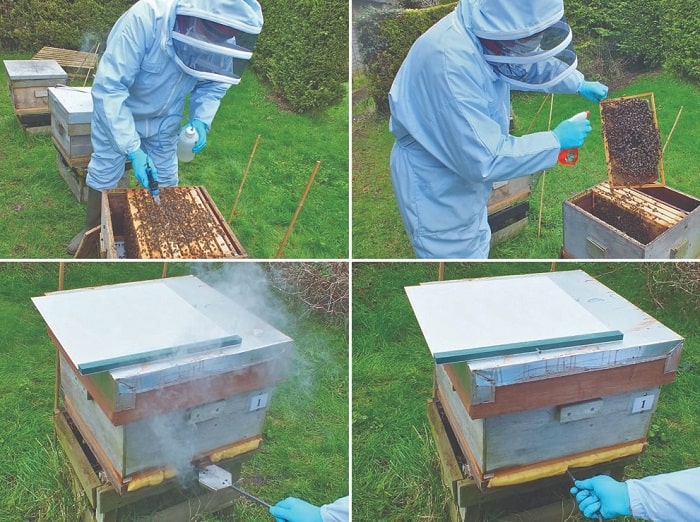Varroa Destructor mites are a major hazard to beekeeping, impacting both amateur and professional beekeepers. For years, researchers have worked to combat this honey bee pest, yet it remains a concern. Oxalic acid is one of the most effective substances used today to control Varroa mite infestations in honey bee hives. So, how much oxalic acid per hive for best effect?
What is oxalic acid?
Oxalic acid is completely natural. It is a natural organic substance present in many plants, including vegetables, leafy greens, fruits, nuts, seeds, and others. Herbivores find oxalic acid repulsive, which is useful if you’re a plant!
The oxalic acid molecule is made up of two carbon, two hydrogen, and four oxygen atoms. It is a colorless solid that dissolves in water to generate a colorless solution. In addition to beekeeping, it has a variety of practical applications, including use as a cleaning or sanitizing agent, and mineral cleaning.

Why is oxalic acid of interest to beekeepers?
It has proven to be a direct and successful treatment for Varroa ticks. People used it for this purpose for many years in Europe and Canada. It was only in 2015 that it was allowed to be used in beehives in the United States. Oxalic acid is inexpensive, natural, and has the potential to be very successful.
How much oxalic acid per hive?
The recommended dosage is one gram per brood chamber. Most have two brood chambers, so use two grams (which is very close to a ½ teaspoonful). You could use a ½ teaspoon measure in lieu of two grams (a quarter teaspoon). More is not better
Oxalic Acid vaporizing for Varroa mites
The use of vapor to deliver oxalic acid into the beehive is an efficient way. It makes use of the physical features of oxalic acid by sublimating it with heat. This necessitates the use of specialized equipment known as vaporizers. An oxalic acid vaporizer is any piece of beekeeping equipment used to heat oxalic acid till it sublimes inside a beehive. Electricity is used to power vaporizers. Depending on the manufacturer, they can operate on both DC and AC power. Things to note:
- A handle, a rod, and an acid pan are all part of an oxalic acid vaporizer.
- All vaporizers have leads that connect the vaporizer to the power source you intend to use.
- You must be near a mains power outlet or have an inverter with you to use vaporizers that work on AC power.
- Those that operate on DC power can be powered by most 12V batteries as long as they are in excellent condition and fully charged.
Oxalic acid vapor enters the beehive and spreads to all of its boxes. It then cools and remains on the hive’s surfaces. As mites wander around the hive, they come into contact with these surfaces. Mites are subject to the effects of oxalic acid in this manner.
The use of oxalic acid vapor often results in a high incidence of mite death within the first two days after treatment. It is critical for beekeepers to understand that oxalic acid from vaporization and fogging lingers in the hive in high enough concentrations to kill mites for up to three days. After that, natural deterioration renders the oxalic acid useless against mites. This is why a follow-up therapy is required after a certain number of weeks.
When vaporizing oxalic acid, you must wear protective clothes. A beekeeping suit with a veil, gloves, and sting-proof footwear is the bare minimum of protective clothing you should own. You should also have a smoker and plugs to shut beehive entrances and exits.
Oxalic acid fogging for Varroa mites
The second way of treating Varroa mites with oxalic acid is fogging. Oxalic acid fogging delivers a considerable volume in a single application. It is quite quickly, allowing beekeepers to travel from one hive to the next in quick succession.
The major piece of equipment required for oxalic acid fogging is, of course, a fogger. This is a high-temperature apparatus that achieves very quick oxalic acid sublimation. Fogger usually prefers to use oxalic acid in its liquid form. Significant foggers may use oxalic acid crystals, although this has some drawbacks.
- When is the best time to use oxalic acid fogging?
Evenings, when bees are less active, are ideal. There will be less activity at the entrance, and all the bees will be within the hive. When hive management activities take place in the middle of the day, when bees are most active, they are not always welcome.

Oxalic Acid bees recipe
- Recipe for fogging
An oxalic acid fog is created with a combination of ethyl alcohol and oxalic acid. To 100ml of ethyl alcohol, 25 grams of oxalic acid powder or crystals are added. Stir the oxalic acid until it is completely dissolved. Depending on the degree of the Varroa mite infection, this is enough to treat 30 to 50 hives.
- Recipe for vaporization
A normal rate of 1 gram of oxalic crystals or powder per beehive box is sufficient for vaporization. When vaporizing oxalic acid, take care to vaporize all of the oxalic acid in the vaporization pan. If you do not allow enough time to fully vaporize, you should not take oxalic acid because it does not have the required dose.
How to mix oxalic acid for bees
Many countries allow the use of oxalic acid to treat beehives for Varroa ticks. Once there, it is used in powder or crystal form. Beekeepers who use oxalic acid foggers to administer the acid in solution for Varroa mite control must appropriately mix the acid. During treatment, people often mix oxalic acid with water, ethyl alcohol, or mineral oil.
- Oxalic acid and water mixture
To make an oxalic acid and water solution, combine 25 grams of oxalic acid with 100ml of water. Make as much of the mixture as you will need to treat all of your hives. 100ml of the combination should be enough for 30-50 beehives. If you can not do it, you will be using too much oxalic acid. Badly infested beehives may require slightly more oxalic acid fogging than less severely contaminated hives.
- Oxalic acid and ethyl alcohol mixture
Ethyl alcohol and oxalic acid solutions are applicable in the fog method. When mixing oxalic acid for a fogger, it is the second best option of solute. People use oxalic acid in powder form as wood bleach. Then add 100 mL of ethyl alcohol and 25 grams of chemical. Make sure you mix this mixture well. A few drops per use. A mixture of 100 mL ethyl alcohol and oxalic acid is sufficient to treat between 30 and 50 beehives.
- Mineral oil and oxalic acid mixture
Before adding mineral oil to oxalic acid for beehive fogging, exercise caution. This is owing to the characteristics of mineral oil, which prevents it from dissolving oxalic acid. As a result, mineral oil can mist in its purest form. Oil is a hydrocarbon that becomes extremely flammable when heated to high temperatures. When mineral oil passes through a layer of fog, it will most likely catch fire.
Important considerations for Oxalic Acid mixtures
- You can store the oxalic acid mixture for a period of time and then use it in successive fogging attempts.
- It is vital to remember that the acid’s quality deteriorates over time. This is visible when the mixture changes color.
- If you intend to utilize the oxalic acid mixture later, do not keep it at room temperature. Refrigerate the mixture at 4 0C (39. 0F) or lower.
- Additionally, keep the mixture out of the reach of children. You should clearly label containers with oxalic acid mixtures.
Conclusion
Oxalic acid is a natural miticide that is effective. Although it is harmful to humans in large amounts, it is rarely harmful in appreciable levels in honey or beeswax. As a result, you may create high-quality, contaminant-free honey. Nonetheless, it is safe to take precautions and remove honey super boxes from your beehives when using oxalic acid.
The best ways to apply oxalic acid in beehives are still vaporization and fogging. The two ways make Varroa mite treatment simple, effective, and efficient.
Related Posts:
